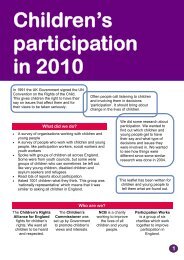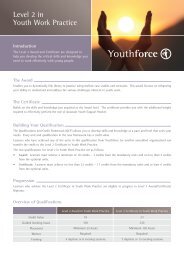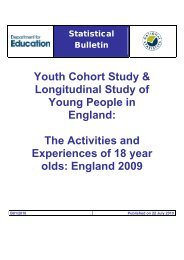The influence of family and friends on young people's drinking
The influence of family and friends on young people's drinking
The influence of family and friends on young people's drinking
You also want an ePaper? Increase the reach of your titles
YUMPU automatically turns print PDFs into web optimized ePapers that Google loves.
<str<strong>on</strong>g>The</str<strong>on</strong>g> <str<strong>on</strong>g>influence</str<strong>on</strong>g> <str<strong>on</strong>g>of</str<strong>on</strong>g><br />
<str<strong>on</strong>g>family</str<strong>on</strong>g> <str<strong>on</strong>g>and</str<strong>on</strong>g> <str<strong>on</strong>g>friends</str<strong>on</strong>g><br />
<strong>on</strong> <strong>young</strong> people’s<br />
<strong>drinking</strong><br />
January 2011<br />
Round-up<br />
Reviewing the evidence<br />
This Round-up examines<br />
<str<strong>on</strong>g>family</str<strong>on</strong>g> <str<strong>on</strong>g>and</str<strong>on</strong>g> <str<strong>on</strong>g>friends</str<strong>on</strong>g>hip<br />
<str<strong>on</strong>g>influence</str<strong>on</strong>g>s <strong>on</strong> <strong>young</strong><br />
people’s <strong>drinking</strong> habits,<br />
in order to shed light <strong>on</strong><br />
how the negative aspects<br />
<str<strong>on</strong>g>of</str<strong>on</strong>g> <strong>young</strong> people’s <strong>drinking</strong><br />
culture in the UK might be<br />
changed.<br />
Author<br />
Arun S<strong>on</strong>dhi <str<strong>on</strong>g>and</str<strong>on</strong>g> Claire Turner<br />
This paper:<br />
• draws <strong>on</strong> five research projects aimed at underst<str<strong>on</strong>g>and</str<strong>on</strong>g>ing how <str<strong>on</strong>g>family</str<strong>on</strong>g> <str<strong>on</strong>g>and</str<strong>on</strong>g><br />
<str<strong>on</strong>g>friends</str<strong>on</strong>g>hip groups <str<strong>on</strong>g>influence</str<strong>on</strong>g> <strong>young</strong> people’s <strong>drinking</strong> cultures;<br />
• examines the implicati<strong>on</strong>s for policy <str<strong>on</strong>g>and</str<strong>on</strong>g> practice interventi<strong>on</strong>s which aim<br />
to reduce alcohol-related harm am<strong>on</strong>g <strong>young</strong> people.<br />
Key points<br />
• Family is a key <str<strong>on</strong>g>influence</str<strong>on</strong>g> <strong>on</strong> children’s <str<strong>on</strong>g>and</str<strong>on</strong>g> <strong>young</strong> people’s behaviour.<br />
Both parents <str<strong>on</strong>g>and</str<strong>on</strong>g> children see the home as a ‘safe’ place to drink.<br />
• Parents develop ways <str<strong>on</strong>g>of</str<strong>on</strong>g> giving their children messages about <strong>drinking</strong>;<br />
these include the ‘c<strong>on</strong>tinental’ style introducti<strong>on</strong> <str<strong>on</strong>g>of</str<strong>on</strong>g> small samples<br />
<str<strong>on</strong>g>of</str<strong>on</strong>g> alcohol to children. Parents tend to rely <strong>on</strong> their own childhood<br />
experiences with alcohol <str<strong>on</strong>g>and</str<strong>on</strong>g> pers<strong>on</strong>al beliefs rather than government<br />
public health messages.<br />
• Parents feel that they are best placed to <str<strong>on</strong>g>influence</str<strong>on</strong>g> their children’s<br />
alcohol intake. Parental supervisi<strong>on</strong> <str<strong>on</strong>g>and</str<strong>on</strong>g> parental <strong>drinking</strong> in fr<strong>on</strong>t<br />
<str<strong>on</strong>g>of</str<strong>on</strong>g> children are key factors that <str<strong>on</strong>g>influence</str<strong>on</strong>g> a child or <strong>young</strong> pers<strong>on</strong>’s<br />
knowledge, attitude <str<strong>on</strong>g>and</str<strong>on</strong>g> behaviour in relati<strong>on</strong> to alcohol.<br />
• Most <strong>young</strong> people do not seek to get out <str<strong>on</strong>g>of</str<strong>on</strong>g> c<strong>on</strong>trol from excessive<br />
<strong>drinking</strong>. Indeed, many viewed this negatively. Although many do drink<br />
to get drunk, <str<strong>on</strong>g>friends</str<strong>on</strong>g>hip groups <str<strong>on</strong>g>of</str<strong>on</strong>g>ten find their own ways to manage<br />
alcohol c<strong>on</strong>sumpti<strong>on</strong> in order to get ‘drunk enough’. Price is more likely<br />
to limit c<strong>on</strong>sumpti<strong>on</strong> than c<strong>on</strong>cerns about health or pers<strong>on</strong>al risk.<br />
• Policy <str<strong>on</strong>g>and</str<strong>on</strong>g> practice implicati<strong>on</strong>s include:<br />
- Preventi<strong>on</strong> <str<strong>on</strong>g>and</str<strong>on</strong>g> harm reducti<strong>on</strong> approaches need to take into<br />
account how parent-child dynamics, social c<strong>on</strong>texts <str<strong>on</strong>g>and</str<strong>on</strong>g> socioec<strong>on</strong>omic<br />
factors all vary.<br />
- Public health messages need to c<strong>on</strong>nect more with the realities <str<strong>on</strong>g>of</str<strong>on</strong>g><br />
parents’ attitudes <str<strong>on</strong>g>and</str<strong>on</strong>g> practices. Parents require informati<strong>on</strong> <str<strong>on</strong>g>and</str<strong>on</strong>g><br />
advice which they can apply flexibly <str<strong>on</strong>g>and</str<strong>on</strong>g> adapt to their individual<br />
approaches as their children grow up.<br />
- Interventi<strong>on</strong>s to enable <strong>young</strong> people to manage their <strong>drinking</strong> need<br />
to c<strong>on</strong>sider group <strong>drinking</strong> situati<strong>on</strong>s <str<strong>on</strong>g>and</str<strong>on</strong>g> decisi<strong>on</strong>-making not just<br />
individuals’ behaviour.<br />
- Further c<strong>on</strong>siderati<strong>on</strong> is needed <str<strong>on</strong>g>of</str<strong>on</strong>g> the potential for using price<br />
as a harm reducti<strong>on</strong> measure <str<strong>on</strong>g>and</str<strong>on</strong>g> the need for more appealing,<br />
alternative spaces for <strong>young</strong> people to socialise with <str<strong>on</strong>g>friends</str<strong>on</strong>g>.<br />
www.jrf.org.uk
Introducti<strong>on</strong><br />
<str<strong>on</strong>g>The</str<strong>on</strong>g> Joseph Rowntree Foundati<strong>on</strong>’s (JRF) Alcohol<br />
Programme aims to c<strong>on</strong>tribute to halting or reversing<br />
negative <strong>drinking</strong> cultures <str<strong>on</strong>g>and</str<strong>on</strong>g> patterns am<strong>on</strong>gst <strong>young</strong><br />
people in the UK. <str<strong>on</strong>g>The</str<strong>on</strong>g> focus <str<strong>on</strong>g>of</str<strong>on</strong>g> the programme is <strong>on</strong><br />
examining the transmissi<strong>on</strong> <str<strong>on</strong>g>of</str<strong>on</strong>g> <strong>drinking</strong> cultures. To this<br />
end, JRF has commissi<strong>on</strong>ed a number <str<strong>on</strong>g>of</str<strong>on</strong>g> research<br />
projects which explore the ways in which <strong>drinking</strong> culture<br />
is transmitted through <str<strong>on</strong>g>influence</str<strong>on</strong>g>s such as <str<strong>on</strong>g>family</str<strong>on</strong>g>, peers,<br />
media <str<strong>on</strong>g>and</str<strong>on</strong>g> locati<strong>on</strong> so as to shed light <strong>on</strong> how <strong>young</strong><br />
people’s negative <strong>drinking</strong> cultures might be changed.<br />
Family <str<strong>on</strong>g>and</str<strong>on</strong>g> <str<strong>on</strong>g>friends</str<strong>on</strong>g>hip <str<strong>on</strong>g>influence</str<strong>on</strong>g>s are key factors in shaping<br />
<strong>young</strong> people’s <strong>drinking</strong> culture. Whilst there are some<br />
points in childhood where <str<strong>on</strong>g>family</str<strong>on</strong>g> or <str<strong>on</strong>g>friends</str<strong>on</strong>g> are more<br />
or less influential, the findings <str<strong>on</strong>g>of</str<strong>on</strong>g> JRF research suggest<br />
that these <str<strong>on</strong>g>influence</str<strong>on</strong>g>s are interc<strong>on</strong>nected <str<strong>on</strong>g>and</str<strong>on</strong>g> that <str<strong>on</strong>g>family</str<strong>on</strong>g><br />
<str<strong>on</strong>g>influence</str<strong>on</strong>g> c<strong>on</strong>tinues as children grow up. Moreover, the<br />
research highlights that <strong>young</strong> people do not have a<br />
<strong>drinking</strong> culture entirely separate from their parents or<br />
other adult relatives.<br />
This Round-up is based <strong>on</strong> the findings <str<strong>on</strong>g>of</str<strong>on</strong>g> five research<br />
projects with a focus <strong>on</strong> <str<strong>on</strong>g>family</str<strong>on</strong>g> <str<strong>on</strong>g>and</str<strong>on</strong>g> peer <str<strong>on</strong>g>influence</str<strong>on</strong>g>s.<br />
Two research projects examined the role <str<strong>on</strong>g>of</str<strong>on</strong>g> the <str<strong>on</strong>g>family</str<strong>on</strong>g><br />
in shaping primary-school-aged children’s knowledge,<br />
attitudes <str<strong>on</strong>g>and</str<strong>on</strong>g> expectati<strong>on</strong>s around alcohol. A third<br />
explored <strong>young</strong> people’s social networks <str<strong>on</strong>g>and</str<strong>on</strong>g> <strong>drinking</strong><br />
behaviour during their teenage years. A fourth project<br />
investigated the <str<strong>on</strong>g>influence</str<strong>on</strong>g>s, motivati<strong>on</strong>s <str<strong>on</strong>g>and</str<strong>on</strong>g> decisi<strong>on</strong>making<br />
which underpins the <strong>drinking</strong> habits <str<strong>on</strong>g>of</str<strong>on</strong>g> <strong>young</strong><br />
adults aged between 18 <str<strong>on</strong>g>and</str<strong>on</strong>g> 25 years. <str<strong>on</strong>g>The</str<strong>on</strong>g> final project<br />
surveyed over 5,700 <strong>young</strong> people at Year 9 (13-14 years)<br />
<str<strong>on</strong>g>and</str<strong>on</strong>g> Year 11 (15-16 years) focusing <strong>on</strong> levels <str<strong>on</strong>g>and</str<strong>on</strong>g> patterns<br />
<str<strong>on</strong>g>of</str<strong>on</strong>g> <strong>drinking</strong> <str<strong>on</strong>g>and</str<strong>on</strong>g> the multiple <str<strong>on</strong>g>influence</str<strong>on</strong>g>s <strong>on</strong> their alcohol<br />
c<strong>on</strong>sumpti<strong>on</strong>.<br />
<str<strong>on</strong>g>The</str<strong>on</strong>g> Round-up also draws <strong>on</strong> supporting evidence from an<br />
earlier JRF research review (Velleman, 2009).<br />
2
<str<strong>on</strong>g>The</str<strong>on</strong>g> role <str<strong>on</strong>g>of</str<strong>on</strong>g> the <str<strong>on</strong>g>family</str<strong>on</strong>g> <str<strong>on</strong>g>and</str<strong>on</strong>g> home<br />
Velleman’s review <str<strong>on</strong>g>of</str<strong>on</strong>g> the literature examining the<br />
factors that prevented excessive alcohol c<strong>on</strong>sumpti<strong>on</strong><br />
am<strong>on</strong>g <strong>young</strong> people suggests that parental <str<strong>on</strong>g>and</str<strong>on</strong>g><br />
<str<strong>on</strong>g>family</str<strong>on</strong>g> <str<strong>on</strong>g>influence</str<strong>on</strong>g>s are at their str<strong>on</strong>gest at an early age.<br />
As a <strong>young</strong> pers<strong>on</strong> gets older this parental <str<strong>on</strong>g>influence</str<strong>on</strong>g><br />
is lessened by messages from the media <str<strong>on</strong>g>and</str<strong>on</strong>g> by the<br />
<str<strong>on</strong>g>influence</str<strong>on</strong>g> <str<strong>on</strong>g>of</str<strong>on</strong>g> their <str<strong>on</strong>g>friends</str<strong>on</strong>g>hip <str<strong>on</strong>g>and</str<strong>on</strong>g> peer groups. <str<strong>on</strong>g>The</str<strong>on</strong>g><br />
JRF research projects c<strong>on</strong>firm the role <str<strong>on</strong>g>of</str<strong>on</strong>g> the <str<strong>on</strong>g>family</str<strong>on</strong>g><br />
<str<strong>on</strong>g>and</str<strong>on</strong>g> parents as the most important <str<strong>on</strong>g>influence</str<strong>on</strong>g> <strong>on</strong><br />
children’s expectati<strong>on</strong>s, attitudes <str<strong>on</strong>g>and</str<strong>on</strong>g> – up to a certain<br />
age – behaviours relating to alcohol use. For <strong>young</strong>er<br />
children (for example, those aged under 13) the home<br />
emerges as a ‘safe’ place to drink alcohol (Eadie,<br />
2010; Valentine, 2010). <str<strong>on</strong>g>The</str<strong>on</strong>g> findings from the Ipsos<br />
MORI survey (forthcoming) suggest that the home<br />
envir<strong>on</strong>ment c<strong>on</strong>tinues to be a potential protective<br />
factor. Here supervised alcohol c<strong>on</strong>sumpti<strong>on</strong> at home<br />
was shown to reduce the likelihood <str<strong>on</strong>g>of</str<strong>on</strong>g> teenagers<br />
<strong>drinking</strong> to excess.<br />
Even at an early age, <strong>young</strong> children have a fairly<br />
sophisticated underst<str<strong>on</strong>g>and</str<strong>on</strong>g>ing <str<strong>on</strong>g>of</str<strong>on</strong>g> alcohol <str<strong>on</strong>g>and</str<strong>on</strong>g> its effects<br />
which mostly comes from observing their parents or<br />
other adult relatives (Eadie, 2010). Many children were<br />
aware <str<strong>on</strong>g>of</str<strong>on</strong>g> their parents’ <str<strong>on</strong>g>and</str<strong>on</strong>g> adult relatives’ <strong>drinking</strong><br />
habits, including their drink preferences. Children were<br />
shown to underst<str<strong>on</strong>g>and</str<strong>on</strong>g> different levels <str<strong>on</strong>g>of</str<strong>on</strong>g> intoxicati<strong>on</strong>.<br />
Girls in particular were seen to have a nuanced<br />
underst<str<strong>on</strong>g>and</str<strong>on</strong>g>ing <str<strong>on</strong>g>of</str<strong>on</strong>g> the links between alcohol use <str<strong>on</strong>g>and</str<strong>on</strong>g><br />
different social situati<strong>on</strong>s (Eadie, 2010).<br />
For most families, alcohol was viewed not as something<br />
bad or hidden, but as a normal, unremarkable feature<br />
<str<strong>on</strong>g>of</str<strong>on</strong>g> everyday life. Many parents felt happy to drink (but<br />
not to get drunk) in fr<strong>on</strong>t <str<strong>on</strong>g>of</str<strong>on</strong>g> their children <str<strong>on</strong>g>and</str<strong>on</strong>g> wanted<br />
to teach them to drink moderately by example (Eadie,<br />
2010; Valentine, 2010).<br />
Parental <str<strong>on</strong>g>influence</str<strong>on</strong>g>s <strong>on</strong> <strong>young</strong>er children<br />
Introducing children to alcohol<br />
<str<strong>on</strong>g>The</str<strong>on</strong>g> parents in Valentine’s study introduced their<br />
children to alcohol with an implicit belief that the home,<br />
rather than school, is a better place to learn about<br />
alcohol. This corresp<strong>on</strong>ds with Velleman’s c<strong>on</strong>cept <str<strong>on</strong>g>of</str<strong>on</strong>g><br />
‘resp<strong>on</strong>sive parenting’ which aims to engage children in<br />
a dialogue about the nature <str<strong>on</strong>g>and</str<strong>on</strong>g> effects <str<strong>on</strong>g>of</str<strong>on</strong>g> alcohol rather<br />
than enforcing more traditi<strong>on</strong>al <str<strong>on</strong>g>family</str<strong>on</strong>g> boundaries that<br />
deny access to alcohol.<br />
<str<strong>on</strong>g>The</str<strong>on</strong>g> survey data in Valentine’s research suggests that<br />
the dominant attitude am<strong>on</strong>g parents is that children<br />
should not be introduced to alcohol at home until their<br />
mid-teens. However, the qualitative element <str<strong>on</strong>g>of</str<strong>on</strong>g> the study<br />
suggests parents actually introduce their children to<br />
alcohol at an earlier age. Alcohol was most comm<strong>on</strong>ly<br />
introduced to children at home or at <str<strong>on</strong>g>family</str<strong>on</strong>g> celebrati<strong>on</strong>s<br />
(Valentine, 2010). This was shown to be similar to a<br />
‘c<strong>on</strong>tinental’ style whereby parents would introduce<br />
alcohol by <str<strong>on</strong>g>of</str<strong>on</strong>g>fering a sip or providing small samples <str<strong>on</strong>g>of</str<strong>on</strong>g><br />
alcohol mixed with water or juice under c<strong>on</strong>trolled or<br />
supervised c<strong>on</strong>diti<strong>on</strong>s. <str<strong>on</strong>g>The</str<strong>on</strong>g> intenti<strong>on</strong> was to encourage<br />
children to drink resp<strong>on</strong>sibly in the future. <str<strong>on</strong>g>The</str<strong>on</strong>g>se<br />
decisi<strong>on</strong>s were taken not <strong>on</strong> the basis <str<strong>on</strong>g>of</str<strong>on</strong>g> public health<br />
messages, but parents’ own childhood experiences or<br />
pers<strong>on</strong>al beliefs (Valentine, 2010).<br />
Teaching children about alcohol<br />
<str<strong>on</strong>g>The</str<strong>on</strong>g> research suggests that at this stage, parents mostly<br />
do a good job <str<strong>on</strong>g>of</str<strong>on</strong>g> c<strong>on</strong>veying the social pleasures <str<strong>on</strong>g>and</str<strong>on</strong>g><br />
risks <str<strong>on</strong>g>of</str<strong>on</strong>g> <strong>drinking</strong> <str<strong>on</strong>g>and</str<strong>on</strong>g> the message that alcohol should<br />
be c<strong>on</strong>sumed in moderati<strong>on</strong> (Eadie, 2010; Valentine,<br />
2010). <str<strong>on</strong>g>The</str<strong>on</strong>g> research indicates that parents <str<strong>on</strong>g>of</str<strong>on</strong>g> <strong>young</strong><br />
children were likely to moderate their own behaviour so<br />
as to set an example; this was particularly noticeable<br />
for mothers (Eadie, 2010). Indeed, <strong>young</strong> children<br />
anticipated modelling their future behaviour <strong>on</strong> their<br />
parents’ <strong>drinking</strong> styles, rather than <strong>on</strong> teenage <strong>drinking</strong><br />
habits (Eadie, 2010; Valentine, 2010).<br />
But, <str<strong>on</strong>g>of</str<strong>on</strong>g> course, parents are not perfect. <str<strong>on</strong>g>The</str<strong>on</strong>g>re were<br />
occasi<strong>on</strong>s where some parents drank to excess in fr<strong>on</strong>t<br />
<str<strong>on</strong>g>of</str<strong>on</strong>g> their children (for example, <strong>on</strong> holiday or at <str<strong>on</strong>g>family</str<strong>on</strong>g><br />
celebrati<strong>on</strong>s) <str<strong>on</strong>g>and</str<strong>on</strong>g> there were gaps in what children<br />
learnt from home. <str<strong>on</strong>g>The</str<strong>on</strong>g> research highlights that children<br />
are not taught to recognise the potential future health<br />
c<strong>on</strong>sequences <str<strong>on</strong>g>of</str<strong>on</strong>g> excessive <strong>drinking</strong>, with parents<br />
tending to focus <strong>on</strong> short-term c<strong>on</strong>sequences such<br />
as hangovers (Valentine, 2010). This may in part be<br />
explained by the fact that health risks do not res<strong>on</strong>ate<br />
with parents’ own experiences. Also, parents’ emphasis<br />
<strong>on</strong> learning to drink safely in the home missed the<br />
opportunity to teach children about <strong>drinking</strong> outside<br />
<str<strong>on</strong>g>of</str<strong>on</strong>g> the home <str<strong>on</strong>g>and</str<strong>on</strong>g> the impact <str<strong>on</strong>g>of</str<strong>on</strong>g> <strong>drinking</strong> behaviours <strong>on</strong><br />
others (Valentine, 2010).<br />
3
Parents did not have specific rules <strong>on</strong> <strong>drinking</strong> as other<br />
issues, such as a child’s use <str<strong>on</strong>g>of</str<strong>on</strong>g> computer games,<br />
were c<strong>on</strong>sidered more pressing, (Valentine, 2010).<br />
Parents preferred to highlight what they saw as more<br />
problematic substances, such as tobacco or illicit<br />
drugs, <str<strong>on</strong>g>and</str<strong>on</strong>g> discussi<strong>on</strong> between parents <str<strong>on</strong>g>and</str<strong>on</strong>g> children<br />
about alcohol was limited (Eadie, 2010). This absence<br />
<str<strong>on</strong>g>of</str<strong>on</strong>g> informati<strong>on</strong> was reflected in a gap in knowledge<br />
am<strong>on</strong>g children about the effects <str<strong>on</strong>g>of</str<strong>on</strong>g> excessive alcohol<br />
c<strong>on</strong>sumpti<strong>on</strong> <str<strong>on</strong>g>and</str<strong>on</strong>g> through children c<strong>on</strong>fusing health<br />
promoti<strong>on</strong> messages about the impact <str<strong>on</strong>g>of</str<strong>on</strong>g> smoking <str<strong>on</strong>g>and</str<strong>on</strong>g><br />
<strong>drinking</strong>.<br />
For some children, witnessing their parents’ excessive<br />
alcohol c<strong>on</strong>sumpti<strong>on</strong> actually had the potential to act<br />
as a moderator for future alcohol use (Valentine, 2010).<br />
Here, seeing a parent in a state <str<strong>on</strong>g>of</str<strong>on</strong>g> inebriati<strong>on</strong> was <str<strong>on</strong>g>of</str<strong>on</strong>g>fputting<br />
to some children <str<strong>on</strong>g>and</str<strong>on</strong>g> actually raised greater<br />
awareness <str<strong>on</strong>g>of</str<strong>on</strong>g> alcohol misuse. In additi<strong>on</strong>, there were<br />
instances when a child expressed disapproval <str<strong>on</strong>g>of</str<strong>on</strong>g> their<br />
parent’s alcohol c<strong>on</strong>sumpti<strong>on</strong> which in turn acted as a<br />
moderator for their parent’s behaviour (Eadie, 2010).<br />
What emerges from this research is a dynamic, complex<br />
series <str<strong>on</strong>g>of</str<strong>on</strong>g> interacti<strong>on</strong>s relating to alcohol, not always from<br />
parent to child but rather between parents <str<strong>on</strong>g>and</str<strong>on</strong>g> their<br />
children.<br />
Parental <str<strong>on</strong>g>influence</str<strong>on</strong>g>s as children grow up<br />
Influences outside the <str<strong>on</strong>g>family</str<strong>on</strong>g><br />
As children get older <str<strong>on</strong>g>and</str<strong>on</strong>g> socialise more with <str<strong>on</strong>g>friends</str<strong>on</strong>g>,<br />
Velleman argues that the pull <str<strong>on</strong>g>of</str<strong>on</strong>g> parental <str<strong>on</strong>g>influence</str<strong>on</strong>g><br />
becomes weaker in favour <str<strong>on</strong>g>of</str<strong>on</strong>g> other external pressures<br />
(Velleman, 2009). Although the research projects<br />
suggest that parents have a vital role in shaping their<br />
children’s alcohol c<strong>on</strong>sumpti<strong>on</strong>, there was a sense<br />
<str<strong>on</strong>g>of</str<strong>on</strong>g> pragmatism am<strong>on</strong>g parents that they would have<br />
a diminishing <str<strong>on</strong>g>influence</str<strong>on</strong>g> as their children grew up at<br />
the expense <str<strong>on</strong>g>of</str<strong>on</strong>g> other external factors such as their<br />
children’s <str<strong>on</strong>g>friends</str<strong>on</strong>g>hip networks (Eadie, 2010; Valentine,<br />
2010).<br />
Percy describes an ‘implicit c<strong>on</strong>tract’ between<br />
<strong>young</strong> people <str<strong>on</strong>g>and</str<strong>on</strong>g> parents <strong>on</strong>ce alcohol begins to<br />
be c<strong>on</strong>sumed outside the <str<strong>on</strong>g>family</str<strong>on</strong>g> home. In return for<br />
parents’ tacit acceptance <str<strong>on</strong>g>of</str<strong>on</strong>g> alcohol c<strong>on</strong>sumpti<strong>on</strong>,<br />
<strong>young</strong> people would deploy strategies aimed at<br />
ensuring that their parents did not see them drunk.<br />
One strategy was for <strong>young</strong> people to drink earlier to<br />
achieve the desired level <str<strong>on</strong>g>of</str<strong>on</strong>g> intoxicati<strong>on</strong> but also to allow<br />
time at the end <str<strong>on</strong>g>of</str<strong>on</strong>g> the evening to sober up so as not to<br />
come home drunk (Percy, forthcoming).<br />
<str<strong>on</strong>g>The</str<strong>on</strong>g>re are mixed findings about the effectiveness <str<strong>on</strong>g>of</str<strong>on</strong>g><br />
parenting strategies in this c<strong>on</strong>text. Research by Ipsos<br />
MORI (forthcoming) suggests that <strong>young</strong> people who<br />
have more supervisi<strong>on</strong> <str<strong>on</strong>g>and</str<strong>on</strong>g> m<strong>on</strong>itoring by a parent (for<br />
example, parents know where their children are <strong>on</strong><br />
a Saturday night) <str<strong>on</strong>g>and</str<strong>on</strong>g> have a parent (or older sibling)<br />
who drinks moderately in fr<strong>on</strong>t <str<strong>on</strong>g>of</str<strong>on</strong>g> them (rather than to<br />
excess) are at a reduced risk <str<strong>on</strong>g>of</str<strong>on</strong>g> <strong>drinking</strong> to excess.<br />
However, Percy’s research found that parental attempts<br />
to restrict their teenager’s c<strong>on</strong>tact with alcohol are <str<strong>on</strong>g>of</str<strong>on</strong>g>ten<br />
circumvented <str<strong>on</strong>g>and</str<strong>on</strong>g> rarely lead to a reducti<strong>on</strong> in <strong>drinking</strong><br />
(Percy, forthcoming). In some situati<strong>on</strong>s parental acti<strong>on</strong>s<br />
actually increase the risk <str<strong>on</strong>g>of</str<strong>on</strong>g> <strong>young</strong> people getting too<br />
drunk. When parents provided <strong>young</strong> people with<br />
limited alcohol within the home, this <str<strong>on</strong>g>of</str<strong>on</strong>g>ten occurred<br />
without them being aware that the <strong>young</strong> pers<strong>on</strong> was<br />
already <strong>drinking</strong> outside the home. Here, parents are<br />
facilitating an increase in c<strong>on</strong>sumpti<strong>on</strong> through providing<br />
additi<strong>on</strong>al alcohol.<br />
<str<strong>on</strong>g>The</str<strong>on</strong>g>re is evidence <str<strong>on</strong>g>of</str<strong>on</strong>g> the <strong>on</strong>going <str<strong>on</strong>g>influence</str<strong>on</strong>g> <str<strong>on</strong>g>of</str<strong>on</strong>g> <str<strong>on</strong>g>family</str<strong>on</strong>g> as<br />
<strong>young</strong> people get older. Seaman’s research with <strong>young</strong><br />
adults indicated that when <strong>drinking</strong> with their parents<br />
or in a <str<strong>on</strong>g>family</str<strong>on</strong>g> c<strong>on</strong>text, <strong>young</strong> people tended to drink<br />
more moderately than with their peers (Seaman, 2010).<br />
Here, parents are helping to establish ideas around the<br />
c<strong>on</strong>textual appropriateness for different <strong>drinking</strong> styles.<br />
Indeed, it appeared it was witnessing examples <str<strong>on</strong>g>of</str<strong>on</strong>g><br />
moderati<strong>on</strong> that <str<strong>on</strong>g>influence</str<strong>on</strong>g>d <strong>young</strong> people, rather than<br />
whether or not parents had introduced them to alcohol<br />
in the home.<br />
Drawing <strong>on</strong> their own experiences, parents accepted<br />
the future erosi<strong>on</strong> <str<strong>on</strong>g>of</str<strong>on</strong>g> natural authority with their children.<br />
Underpinning this was a sense that parents felt<br />
overwhelmed by the volume <str<strong>on</strong>g>of</str<strong>on</strong>g> external pressures that<br />
they felt were being placed <strong>on</strong> their children through, for<br />
example, pervasive alcohol advertising (Eadie, 2010).<br />
Parenting strategies<br />
Parents were increasingly shown to develop an<br />
‘individualised strategy’ (Valentine, 2010) to equip their<br />
children to manage their own alcohol c<strong>on</strong>sumpti<strong>on</strong>.<br />
Broad public health messages aimed at reducing<br />
c<strong>on</strong>sumpti<strong>on</strong> levels did not seem to res<strong>on</strong>ate with<br />
parents who were required to adapt their strategies in<br />
resp<strong>on</strong>se to a range <str<strong>on</strong>g>of</str<strong>on</strong>g> increasingly complex factors.<br />
4
Drinking with <str<strong>on</strong>g>friends</str<strong>on</strong>g><br />
A ‘culture <str<strong>on</strong>g>of</str<strong>on</strong>g> intoxicati<strong>on</strong>’<br />
<str<strong>on</strong>g>The</str<strong>on</strong>g> research projects found that both teenagers <str<strong>on</strong>g>and</str<strong>on</strong>g><br />
<strong>young</strong> adults navigate a ‘culture <str<strong>on</strong>g>of</str<strong>on</strong>g> intoxicati<strong>on</strong>’ (Percy,<br />
forthcoming; Seaman, 2010). When <strong>drinking</strong> with<br />
<str<strong>on</strong>g>friends</str<strong>on</strong>g>, <strong>young</strong> people are <strong>drinking</strong> to get drunk. Many<br />
(although not all) <str<strong>on</strong>g>friends</str<strong>on</strong>g>hip groups actively pursue<br />
drunkenness. Here <strong>young</strong> people described excessive<br />
<strong>drinking</strong> as <strong>on</strong>e <str<strong>on</strong>g>of</str<strong>on</strong>g> the few occasi<strong>on</strong>s in their lives<br />
for relaxing, having fun <str<strong>on</strong>g>and</str<strong>on</strong>g> making <str<strong>on</strong>g>and</str<strong>on</strong>g> maintaining<br />
<str<strong>on</strong>g>friends</str<strong>on</strong>g>hips. Young people found it hard to imagine ways<br />
<str<strong>on</strong>g>of</str<strong>on</strong>g> spending time with their <str<strong>on</strong>g>friends</str<strong>on</strong>g> without <strong>drinking</strong><br />
(Seaman, 2010). Research into <str<strong>on</strong>g>friends</str<strong>on</strong>g>hip networks<br />
am<strong>on</strong>g <strong>young</strong> people under the legal <strong>drinking</strong> age<br />
showed that increased alcohol c<strong>on</strong>sumpti<strong>on</strong> was<br />
shown to c<strong>on</strong>fer a degree <str<strong>on</strong>g>of</str<strong>on</strong>g> social st<str<strong>on</strong>g>and</str<strong>on</strong>g>ing am<strong>on</strong>g<br />
some groups <str<strong>on</strong>g>of</str<strong>on</strong>g> <strong>young</strong> people (Percy, forthcoming).<br />
<str<strong>on</strong>g>The</str<strong>on</strong>g> survey findings from Ipsos Mori indicate that the<br />
perceived <strong>drinking</strong> behaviour <str<strong>on</strong>g>of</str<strong>on</strong>g> <str<strong>on</strong>g>friends</str<strong>on</strong>g> was a key factor<br />
in <strong>young</strong> people’s <strong>drinking</strong> habits. For example, <strong>young</strong><br />
people were much more likely to admit <strong>drinking</strong> in the<br />
last week if most (as opposed to some or a few) <str<strong>on</strong>g>of</str<strong>on</strong>g><br />
their <str<strong>on</strong>g>friends</str<strong>on</strong>g> did too. <str<strong>on</strong>g>The</str<strong>on</strong>g> amount c<strong>on</strong>sumed (in terms<br />
<str<strong>on</strong>g>of</str<strong>on</strong>g> volume per <strong>drinking</strong> sessi<strong>on</strong>) was also shown to be<br />
associated; the more their <str<strong>on</strong>g>friends</str<strong>on</strong>g> drank, the more a<br />
<strong>young</strong> pers<strong>on</strong> admitted <strong>drinking</strong>.<br />
Although <strong>young</strong> people were <strong>drinking</strong> to get drunk,<br />
simplistic portrayals <str<strong>on</strong>g>of</str<strong>on</strong>g> this as ‘out <str<strong>on</strong>g>of</str<strong>on</strong>g> c<strong>on</strong>trol binge<br />
<strong>drinking</strong>’ do not appear to reflect the reality <str<strong>on</strong>g>of</str<strong>on</strong>g> <strong>young</strong><br />
people’s <strong>drinking</strong> behaviour. <str<strong>on</strong>g>The</str<strong>on</strong>g>y rarely set out to drink<br />
so much that they are sick, lose c<strong>on</strong>trol or pass out.<br />
In fact, there is c<strong>on</strong>siderable stigma associated with<br />
getting too drunk, with <strong>young</strong> drinkers in particular<br />
placing c<strong>on</strong>siderable emphasis <strong>on</strong> being able to c<strong>on</strong>trol<br />
their <strong>drinking</strong> (Percy, forthcoming).<br />
Most <strong>young</strong> people were not c<strong>on</strong>cerned about their<br />
levels <str<strong>on</strong>g>of</str<strong>on</strong>g> c<strong>on</strong>sumpti<strong>on</strong>. <str<strong>on</strong>g>The</str<strong>on</strong>g>y saw <strong>young</strong> adulthood as<br />
a safe period for regular heaving <strong>drinking</strong> – a time <str<strong>on</strong>g>of</str<strong>on</strong>g><br />
independence without resp<strong>on</strong>sibilities. Young people<br />
perceived their current style <str<strong>on</strong>g>of</str<strong>on</strong>g> <strong>drinking</strong> as temporary,<br />
believing that they would drink more moderately when<br />
they reached full adulthood <str<strong>on</strong>g>and</str<strong>on</strong>g> took <strong>on</strong> resp<strong>on</strong>sibilities<br />
such as getting a job or starting a <str<strong>on</strong>g>family</str<strong>on</strong>g>. (Seaman,<br />
2010; Percy, forthcoming).<br />
Managing c<strong>on</strong>sumpti<strong>on</strong><br />
Drinking culture is not static; it evolves over time as<br />
<strong>young</strong> people become more experienced c<strong>on</strong>sumers<br />
(Percy, forthcoming). Friendship groups develop their<br />
own <strong>drinking</strong> cultures, habits <str<strong>on</strong>g>and</str<strong>on</strong>g> customs. <str<strong>on</strong>g>The</str<strong>on</strong>g>se<br />
customs cover what they drink, how much they drink,<br />
where they drink <str<strong>on</strong>g>and</str<strong>on</strong>g> their intended level <str<strong>on</strong>g>of</str<strong>on</strong>g> intoxicati<strong>on</strong>.<br />
Whilst most <strong>young</strong> people would pursue drunkenness,<br />
the level <str<strong>on</strong>g>of</str<strong>on</strong>g> intoxicati<strong>on</strong> that was acceptable within<br />
the group did vary across <str<strong>on</strong>g>friends</str<strong>on</strong>g>hip groups (Percy,<br />
forthcoming). Groups also develop strategies to regulate<br />
their <strong>drinking</strong> upwards (if they are not drunk enough) or<br />
downwards (if they are getting too drunk).<br />
Teenagers strive to develop <strong>drinking</strong> expertise, the<br />
ability to c<strong>on</strong>trol their level <str<strong>on</strong>g>of</str<strong>on</strong>g> intoxicati<strong>on</strong>. When<br />
attempting to manage their c<strong>on</strong>sumpti<strong>on</strong>, <strong>young</strong><br />
drinkers walk what Percy describes as an ‘intoxicati<strong>on</strong><br />
tightrope’ – trying to balance the desire to get<br />
sufficiently drunk <str<strong>on</strong>g>and</str<strong>on</strong>g> have a good time, with their ability<br />
to sober up before going home to their parents.<br />
Over time, most teenagers appear to develop a<br />
degree <str<strong>on</strong>g>of</str<strong>on</strong>g> self-c<strong>on</strong>trol over their alcohol c<strong>on</strong>sumpti<strong>on</strong>.<br />
However, this is gained through trial <str<strong>on</strong>g>and</str<strong>on</strong>g> error, with<br />
mistakes occurring al<strong>on</strong>g the way. Teenage drinkers<br />
are particularly vulnerable when they change the social<br />
c<strong>on</strong>text in which they drink alcohol, for example when<br />
they move from <strong>drinking</strong> <strong>on</strong> the street to <strong>drinking</strong> in<br />
pubs <str<strong>on</strong>g>and</str<strong>on</strong>g> clubs, or when they go <strong>on</strong> holiday without<br />
their parents for the first time. Here their established<br />
<strong>drinking</strong> culture fails to protect them in the new social<br />
situati<strong>on</strong> (Percy, forthcoming).<br />
‘Pre-loading’ was <strong>on</strong>e way in which <strong>young</strong> adults<br />
managed their alcohol intake. Here, alcohol would<br />
be c<strong>on</strong>sumed at home prior to going out (Seaman,<br />
2010). This might include a friend’s home where alcohol<br />
would be cheaply c<strong>on</strong>sumed to the requisite level <str<strong>on</strong>g>of</str<strong>on</strong>g><br />
intoxicati<strong>on</strong> before going out for the evening. Pubs <str<strong>on</strong>g>and</str<strong>on</strong>g><br />
clubs were <str<strong>on</strong>g>of</str<strong>on</strong>g>ten seen as an expensive night out <str<strong>on</strong>g>and</str<strong>on</strong>g><br />
staying in for a period <str<strong>on</strong>g>of</str<strong>on</strong>g> time prior to going out was<br />
seen to <str<strong>on</strong>g>of</str<strong>on</strong>g>fer a more cost-efficient opti<strong>on</strong> (Seaman,<br />
2010). Yet as Seaman <str<strong>on</strong>g>and</str<strong>on</strong>g> colleagues persuasively<br />
argue, ‘seeing domestic <strong>drinking</strong> as exclusively<br />
ec<strong>on</strong>omically motivated misses the point <str<strong>on</strong>g>of</str<strong>on</strong>g> why <strong>young</strong><br />
people choose to socialise in the first place’. In this<br />
c<strong>on</strong>text, ‘pre-loading’ provides a social functi<strong>on</strong>, namely<br />
socialising with <str<strong>on</strong>g>friends</str<strong>on</strong>g> <str<strong>on</strong>g>and</str<strong>on</strong>g> peers in a more c<strong>on</strong>vivial<br />
envir<strong>on</strong>ment than can be achieved within a bar or club.<br />
5
Price <str<strong>on</strong>g>and</str<strong>on</strong>g> the <strong>drinking</strong> envir<strong>on</strong>ment<br />
In deciding how much to drink, the m<strong>on</strong>ey <strong>young</strong><br />
people were able to spend was more likely than other<br />
factors to curtail how much they drank; they did not<br />
set limits based <strong>on</strong> alcohol units or health or pers<strong>on</strong>al<br />
risks (Percy, forthcoming; Seaman, 2010). One way <str<strong>on</strong>g>of</str<strong>on</strong>g><br />
trying to limit c<strong>on</strong>sumpti<strong>on</strong> was to <strong>on</strong>ly take a restricted<br />
amount <str<strong>on</strong>g>of</str<strong>on</strong>g> m<strong>on</strong>ey <strong>on</strong> a night out – although the cheap<br />
alcohol <str<strong>on</strong>g>of</str<strong>on</strong>g>fers in bars <str<strong>on</strong>g>and</str<strong>on</strong>g> clubs could undermine that<br />
strategy.<br />
On this basis, price could be seen as a more effective<br />
indicator (that ‘makes sense’ to <strong>young</strong> people – quoted<br />
from Seaman, 2010) <str<strong>on</strong>g>of</str<strong>on</strong>g> c<strong>on</strong>sumpti<strong>on</strong> levels than units<br />
<str<strong>on</strong>g>and</str<strong>on</strong>g> therefore could act as a potential moderator <str<strong>on</strong>g>of</str<strong>on</strong>g><br />
alcohol use. <str<strong>on</strong>g>The</str<strong>on</strong>g>re were some (usually those that were<br />
already doing so) who said that if they were priced out<br />
<str<strong>on</strong>g>of</str<strong>on</strong>g> alcohol c<strong>on</strong>sumpti<strong>on</strong>, they might seek intoxicati<strong>on</strong><br />
through black market alcohol or other illegal drugs.<br />
Others said that they would find ways to c<strong>on</strong>sume<br />
alcohol whatever the price, for example by changing to<br />
cheaper br<str<strong>on</strong>g>and</str<strong>on</strong>g>s (Percy, forthcoming; Seaman, 2010).<br />
Seaman’s research found that <strong>young</strong> people matched<br />
their <strong>drinking</strong> to the norms <str<strong>on</strong>g>of</str<strong>on</strong>g> a given situati<strong>on</strong>. Bars<br />
<str<strong>on</strong>g>and</str<strong>on</strong>g> clubs aimed at <strong>young</strong> adults <str<strong>on</strong>g>of</str<strong>on</strong>g>ten encouraged or<br />
exaggerated an excessive <strong>drinking</strong> culture, especially<br />
when drinks were cheap <str<strong>on</strong>g>and</str<strong>on</strong>g> it was st<str<strong>on</strong>g>and</str<strong>on</strong>g>ing room<br />
<strong>on</strong>ly. When <strong>drinking</strong> with their <str<strong>on</strong>g>family</str<strong>on</strong>g> or with mixed age<br />
groups, <strong>young</strong> people tended to moderate their alcohol<br />
c<strong>on</strong>sumpti<strong>on</strong> (Percy, forthcoming; Seaman, 2010).<br />
However, the social worlds <str<strong>on</strong>g>of</str<strong>on</strong>g> <strong>young</strong> people <str<strong>on</strong>g>and</str<strong>on</strong>g> adults<br />
were largely separate, limiting <strong>young</strong> people’s exposure<br />
to a variety <str<strong>on</strong>g>of</str<strong>on</strong>g> attitudes to alcohol <str<strong>on</strong>g>and</str<strong>on</strong>g> different, more<br />
moderate, <strong>drinking</strong> styles.<br />
Socio-ec<strong>on</strong>omic factors<br />
<str<strong>on</strong>g>The</str<strong>on</strong>g>re were many comm<strong>on</strong>alities across socioec<strong>on</strong>omic<br />
groups; including parents’ belief that home<br />
was the best place to introduce children to alcohol,<br />
parental acceptance <str<strong>on</strong>g>of</str<strong>on</strong>g> the perceived inevitability <str<strong>on</strong>g>of</str<strong>on</strong>g> their<br />
children’s future experimentati<strong>on</strong> with excessive alcohol<br />
use, <str<strong>on</strong>g>and</str<strong>on</strong>g> <strong>young</strong> people claiming relatively easy access<br />
to alcohol. Although the samples used in the research<br />
were relatively small, it was possible to dem<strong>on</strong>strate a<br />
complex interacti<strong>on</strong> between alcohol c<strong>on</strong>sumpti<strong>on</strong> <str<strong>on</strong>g>and</str<strong>on</strong>g><br />
wider social-ec<strong>on</strong>omic factors.<br />
One difference was the way children were socialised<br />
to alcohol both at home <str<strong>on</strong>g>and</str<strong>on</strong>g> in the wider community.<br />
Children from affluent areas were more likely to be<br />
exposed to alcohol at mealtimes <str<strong>on</strong>g>and</str<strong>on</strong>g> less likely than<br />
children from deprived areas to be involved in <str<strong>on</strong>g>family</str<strong>on</strong>g><br />
celebrati<strong>on</strong>s where alcohol was c<strong>on</strong>sumed <str<strong>on</strong>g>and</str<strong>on</strong>g><br />
to witness drunkenness in the home or the wider<br />
community (Eadie, 2010). Parents from less affluent<br />
areas were aware <str<strong>on</strong>g>of</str<strong>on</strong>g> this dilemma; some felt acutely the<br />
danger <str<strong>on</strong>g>of</str<strong>on</strong>g> being stigmatised as a ‘bad parent’. However,<br />
the research does not provide evidence that there was<br />
less alcohol c<strong>on</strong>sumpti<strong>on</strong> in affluent areas, but rather<br />
suggests that it was more hidden.<br />
When looking at <strong>young</strong> adults, Seaman’s research<br />
c<strong>on</strong>cludes that the potential for alcohol-related harm<br />
is not the same across all groups. For those <strong>young</strong><br />
people with fewer socio-ec<strong>on</strong>omic resources excessive<br />
c<strong>on</strong>sumpti<strong>on</strong> was more likely to be in private houses<br />
or public spaces (streets or parks) where they were at<br />
greater risk <str<strong>on</strong>g>of</str<strong>on</strong>g> alcohol-related violence. Those who find<br />
it difficult to attain aspects <str<strong>on</strong>g>of</str<strong>on</strong>g> full adulthood, such as a<br />
steady job or independent housing, had more difficulty<br />
imagining their excessive <strong>drinking</strong> style changing in the<br />
future.<br />
6
Implicati<strong>on</strong>s for policy <str<strong>on</strong>g>and</str<strong>on</strong>g> practice<br />
This research indicates that parents <str<strong>on</strong>g>and</str<strong>on</strong>g> <strong>young</strong> people<br />
are sophisticated c<strong>on</strong>sumers <str<strong>on</strong>g>of</str<strong>on</strong>g> alcohol <str<strong>on</strong>g>and</str<strong>on</strong>g> that any<br />
public health messages need to reflect the complexities<br />
<str<strong>on</strong>g>of</str<strong>on</strong>g> alcohol c<strong>on</strong>sumpti<strong>on</strong> <str<strong>on</strong>g>and</str<strong>on</strong>g> the dynamic transmissi<strong>on</strong><br />
<str<strong>on</strong>g>of</str<strong>on</strong>g> informati<strong>on</strong> between parents <str<strong>on</strong>g>and</str<strong>on</strong>g> their children.<br />
Simple, didactic public health messages did not have<br />
much res<strong>on</strong>ance with the parents <str<strong>on</strong>g>and</str<strong>on</strong>g> <strong>young</strong> people in<br />
these studies because such messages did not appear<br />
to be grounded in the reality <str<strong>on</strong>g>of</str<strong>on</strong>g> their alcohol use.<br />
Parental advice <str<strong>on</strong>g>and</str<strong>on</strong>g> guidance<br />
<str<strong>on</strong>g>The</str<strong>on</strong>g> research presents parents as important brokers <str<strong>on</strong>g>of</str<strong>on</strong>g><br />
informati<strong>on</strong> <str<strong>on</strong>g>and</str<strong>on</strong>g> <str<strong>on</strong>g>family</str<strong>on</strong>g> life as complex set <str<strong>on</strong>g>of</str<strong>on</strong>g> interacti<strong>on</strong>s<br />
between parents <str<strong>on</strong>g>and</str<strong>on</strong>g> children. Furthermore, for most,<br />
<strong>drinking</strong> was seen as a normal, unremarkable feature<br />
<str<strong>on</strong>g>of</str<strong>on</strong>g> everyday life. As a result, simple health messages<br />
did not have much meaning for parents. This suggests<br />
that any advice or guidance for parents needs to be<br />
grounded in the reality <str<strong>on</strong>g>of</str<strong>on</strong>g> alcohol use <str<strong>on</strong>g>and</str<strong>on</strong>g> the different<br />
approaches <str<strong>on</strong>g>of</str<strong>on</strong>g> individual parents. Clearly, public health<br />
messages which advocate an alcohol-free childhood<br />
do not reflect the variety <str<strong>on</strong>g>of</str<strong>on</strong>g> strategies <str<strong>on</strong>g>and</str<strong>on</strong>g> approaches<br />
used by parents who attempt to guide their children<br />
towards acceptable alcohol c<strong>on</strong>sumpti<strong>on</strong> in a safe,<br />
c<strong>on</strong>trolled envir<strong>on</strong>ment. Advice to parents which ignores<br />
their current practices may lack credibility <str<strong>on</strong>g>and</str<strong>on</strong>g> be more<br />
likely to be rejected or ignored.<br />
<str<strong>on</strong>g>The</str<strong>on</strong>g> research highlights that <strong>drinking</strong> is a dynamic<br />
phenomen<strong>on</strong> <str<strong>on</strong>g>and</str<strong>on</strong>g> that parents need advice which is<br />
age-appropriate. <str<strong>on</strong>g>The</str<strong>on</strong>g> fairly sophisticated underst<str<strong>on</strong>g>and</str<strong>on</strong>g>ing<br />
<str<strong>on</strong>g>of</str<strong>on</strong>g> alcohol <str<strong>on</strong>g>and</str<strong>on</strong>g> its effects am<strong>on</strong>gst <strong>young</strong> children in the<br />
studies suggests the importance <str<strong>on</strong>g>of</str<strong>on</strong>g> parenting strategies<br />
relating to alcohol from a <strong>young</strong> age. Also at this age<br />
children appear to be receptive to parental advice<br />
<str<strong>on</strong>g>and</str<strong>on</strong>g> guidance, which diminishes in teenage years. For<br />
older children, parents may need to c<strong>on</strong>sider that their<br />
children are c<strong>on</strong>suming alcohol outside <str<strong>on</strong>g>of</str<strong>on</strong>g> the home<br />
much earlier than they anticipated.<br />
Harm reducti<strong>on</strong> approaches for <strong>young</strong> people<br />
<str<strong>on</strong>g>The</str<strong>on</strong>g> findings <str<strong>on</strong>g>of</str<strong>on</strong>g> the JRF research projects indicate<br />
that any interventi<strong>on</strong>s which aim to reduce alcoholrelated<br />
harm am<strong>on</strong>g <strong>young</strong> people need to c<strong>on</strong>sider<br />
how <strong>young</strong> people make decisi<strong>on</strong>s around alcohol<br />
c<strong>on</strong>sumpti<strong>on</strong> <str<strong>on</strong>g>and</str<strong>on</strong>g> the strategies that <strong>young</strong><br />
people themselves already use to try <str<strong>on</strong>g>and</str<strong>on</strong>g> manage<br />
c<strong>on</strong>sumpti<strong>on</strong>.<br />
Underst<str<strong>on</strong>g>and</str<strong>on</strong>g>ing <strong>young</strong> people’s decisi<strong>on</strong>-making around<br />
alcohol<br />
Young people’s decisi<strong>on</strong>-making around alcohol is<br />
<str<strong>on</strong>g>of</str<strong>on</strong>g>ten based <strong>on</strong> c<strong>on</strong>textual criteria (who they were with,<br />
where they were <strong>drinking</strong>). Furthermore, <strong>drinking</strong> is<br />
almost entirely a social activity – <strong>young</strong> people did not<br />
drink al<strong>on</strong>e. <str<strong>on</strong>g>The</str<strong>on</strong>g>refore harm reducti<strong>on</strong> approaches that<br />
focus <strong>on</strong> individual decisi<strong>on</strong>-making (say in relati<strong>on</strong> to<br />
health or pers<strong>on</strong>al risks) do not appear robust enough<br />
to limit c<strong>on</strong>sumpti<strong>on</strong> in <str<strong>on</strong>g>friends</str<strong>on</strong>g>hip group settings <str<strong>on</strong>g>and</str<strong>on</strong>g><br />
<strong>on</strong>ce intoxicati<strong>on</strong> has been reached. Advice <str<strong>on</strong>g>and</str<strong>on</strong>g><br />
interventi<strong>on</strong>s which aim to enable <strong>young</strong> people to<br />
manage group <strong>drinking</strong> situati<strong>on</strong>s as well as their own<br />
c<strong>on</strong>sumpti<strong>on</strong> <str<strong>on</strong>g>and</str<strong>on</strong>g> alcohol-related behaviours may be<br />
more appropriate.<br />
Developing strategies for <strong>young</strong> drinkers<br />
<str<strong>on</strong>g>The</str<strong>on</strong>g> research findings suggest that alcohol interventi<strong>on</strong>s<br />
targeted at <strong>young</strong> teenagers which aim to prevent<br />
or delay initiati<strong>on</strong> into alcohol use, do not take into<br />
c<strong>on</strong>siderati<strong>on</strong> that <strong>young</strong> people may start <strong>drinking</strong> at a<br />
much earlier age than anticipated.<br />
Teenagers do engage in risky behaviours when drunk<br />
<str<strong>on</strong>g>and</str<strong>on</strong>g> although many do learn to moderate their alcohol<br />
c<strong>on</strong>sumpti<strong>on</strong> as they get older this learning is gained<br />
through trial <str<strong>on</strong>g>and</str<strong>on</strong>g> error, in the company <str<strong>on</strong>g>of</str<strong>on</strong>g> other <strong>young</strong><br />
people trying to get drunk but not caught, <str<strong>on</strong>g>and</str<strong>on</strong>g> without<br />
any real adult input. Also, the strategies used by<br />
teenagers to c<strong>on</strong>trol their <strong>drinking</strong> <str<strong>on</strong>g>and</str<strong>on</strong>g> intoxicati<strong>on</strong><br />
are relatively simplistic, pr<strong>on</strong>e to failure <str<strong>on</strong>g>and</str<strong>on</strong>g> <str<strong>on</strong>g>of</str<strong>on</strong>g> little<br />
use if the c<strong>on</strong>text changes. This suggests a need for<br />
the development <str<strong>on</strong>g>of</str<strong>on</strong>g> more pragmatic interventi<strong>on</strong>s<br />
for underage drinkers that are focused <strong>on</strong> reducing<br />
the acute risks associated with their <strong>drinking</strong>. <str<strong>on</strong>g>The</str<strong>on</strong>g>se<br />
interventi<strong>on</strong>s could attempt to teach <strong>young</strong> drinkers<br />
better strategies <str<strong>on</strong>g>and</str<strong>on</strong>g> techniques to c<strong>on</strong>trol <str<strong>on</strong>g>and</str<strong>on</strong>g><br />
regulate their c<strong>on</strong>sumpti<strong>on</strong> <str<strong>on</strong>g>and</str<strong>on</strong>g> to reduce instances <str<strong>on</strong>g>of</str<strong>on</strong>g><br />
excessive.<br />
Price as a moderator <str<strong>on</strong>g>of</str<strong>on</strong>g> c<strong>on</strong>sumpti<strong>on</strong><br />
Price is already <strong>on</strong>e measure by which <strong>young</strong> people<br />
m<strong>on</strong>itor their alcohol c<strong>on</strong>sumpti<strong>on</strong>. This suggests that<br />
increasing the minimum price <str<strong>on</strong>g>of</str<strong>on</strong>g> alcohol, or at least<br />
banning low-cost alcohol <str<strong>on</strong>g>and</str<strong>on</strong>g> discounted alcohol<br />
promoti<strong>on</strong>s, is more likely to curtail <strong>drinking</strong> than<br />
approaches focused <strong>on</strong> the health c<strong>on</strong>sequences <str<strong>on</strong>g>of</str<strong>on</strong>g><br />
<strong>drinking</strong> or <strong>on</strong> counting units. However, it is important<br />
to note that manipulating price may not be sufficient<br />
to remove <strong>young</strong> people’s motivati<strong>on</strong> for excessive<br />
<strong>drinking</strong> with <str<strong>on</strong>g>friends</str<strong>on</strong>g>. Furthermore, if priced out <str<strong>on</strong>g>of</str<strong>on</strong>g><br />
alcohol c<strong>on</strong>sumpti<strong>on</strong>, some <strong>young</strong> people may choose<br />
to substitute alcohol with black market alcohol or other<br />
drugs.<br />
7
Alternative social spaces<br />
C<strong>on</strong>trolling the price <str<strong>on</strong>g>and</str<strong>on</strong>g> availability <str<strong>on</strong>g>of</str<strong>on</strong>g> alcohol should<br />
limit the amount drunk <strong>on</strong> <strong>on</strong>e night out, but it fails to<br />
tackle the cultural issue, namely that socialising has<br />
become syn<strong>on</strong>ymous with <strong>drinking</strong> for <strong>young</strong> adults in<br />
the UK. If <strong>young</strong> people are <strong>drinking</strong> to excess in order<br />
to participate <str<strong>on</strong>g>and</str<strong>on</strong>g> bel<strong>on</strong>g, then there is an impetus<br />
to create more appealing, alternative social spaces<br />
for them to relax, have fun <str<strong>on</strong>g>and</str<strong>on</strong>g> socialise with <str<strong>on</strong>g>friends</str<strong>on</strong>g>.<br />
Based <strong>on</strong> the findings <str<strong>on</strong>g>of</str<strong>on</strong>g> this research, this would need<br />
to move away from the idea <str<strong>on</strong>g>of</str<strong>on</strong>g> trying to ‘divert’ <strong>young</strong><br />
people from <strong>drinking</strong> but to try <str<strong>on</strong>g>and</str<strong>on</strong>g> address what is<br />
seen by <strong>young</strong> people as ‘missing’ <str<strong>on</strong>g>and</str<strong>on</strong>g> which can <strong>on</strong>ly<br />
been found through excessive c<strong>on</strong>sumpti<strong>on</strong>. Given the<br />
success <str<strong>on</strong>g>of</str<strong>on</strong>g> youth-orientated clubs <str<strong>on</strong>g>and</str<strong>on</strong>g> bars, this trend<br />
may be hard to reverse.<br />
About this paper<br />
This paper was written by Arun S<strong>on</strong>dhi, independent<br />
c<strong>on</strong>sultant, <str<strong>on</strong>g>and</str<strong>on</strong>g> Claire Turner, manager <str<strong>on</strong>g>of</str<strong>on</strong>g> the JRF<br />
Alcohol Programme, with support from Betsy Thom,<br />
Middlesex University.<br />
<str<strong>on</strong>g>The</str<strong>on</strong>g> research<br />
All the reports are published by JRF <str<strong>on</strong>g>and</str<strong>on</strong>g> are available<br />
for free download <strong>on</strong> publicati<strong>on</strong> from www.jrf.org.uk.<br />
Eadie D., MacAskill S., Brooks O., Heim D., Forsyth A.,<br />
<str<strong>on</strong>g>and</str<strong>on</strong>g> Punch S. (2010) Pre-teens learning about alcohol:<br />
Drinking <str<strong>on</strong>g>and</str<strong>on</strong>g> <str<strong>on</strong>g>family</str<strong>on</strong>g> c<strong>on</strong>texts<br />
Ipsos Mori (forthcoming 2011), Multiple domains<br />
research <strong>on</strong> <strong>drinking</strong> cultures: predicting a <strong>young</strong><br />
pers<strong>on</strong>’s behaviour with alcohol<br />
Percy A., Wils<strong>on</strong> J., McCartan C. <str<strong>on</strong>g>and</str<strong>on</strong>g> McCrystal P.<br />
(forthcoming, February 2011) Teenage <strong>drinking</strong> cultures<br />
Seaman P. <str<strong>on</strong>g>and</str<strong>on</strong>g> Ikegwu<strong>on</strong>u T. (2010) Drinking to bel<strong>on</strong>g:<br />
Underst<str<strong>on</strong>g>and</str<strong>on</strong>g>ing <strong>young</strong> adults’ alcohol use within social<br />
networks<br />
Valentine G., Jayne M., Gould M. <str<strong>on</strong>g>and</str<strong>on</strong>g> Keenan J. (2010)<br />
Family life <str<strong>on</strong>g>and</str<strong>on</strong>g> alcohol c<strong>on</strong>sumpti<strong>on</strong>: A study <str<strong>on</strong>g>of</str<strong>on</strong>g> the<br />
transmissi<strong>on</strong> <str<strong>on</strong>g>of</str<strong>on</strong>g> <strong>drinking</strong> practices<br />
Velleman, R. (2009) Children, <strong>young</strong> people <str<strong>on</strong>g>and</str<strong>on</strong>g> alcohol:<br />
How they learn <str<strong>on</strong>g>and</str<strong>on</strong>g> how to prevent excessive use<br />
Published by the Joseph Rowntree Foundati<strong>on</strong>, <str<strong>on</strong>g>The</str<strong>on</strong>g> Homestead,<br />
40 Water End, York YO30 6WP. This project is part <str<strong>on</strong>g>of</str<strong>on</strong>g> the JRF’s research<br />
<str<strong>on</strong>g>and</str<strong>on</strong>g> development programme. <str<strong>on</strong>g>The</str<strong>on</strong>g>se findings, however, are those <str<strong>on</strong>g>of</str<strong>on</strong>g> the<br />
authors <str<strong>on</strong>g>and</str<strong>on</strong>g> not necessarily those <str<strong>on</strong>g>of</str<strong>on</strong>g> the Foundati<strong>on</strong>.<br />
ISSN 0958-3084 ISBN 978 1 85935 820 7<br />
Read more Round-ups at www.jrf.org.uk<br />
Other formats available.<br />
Tel: 01904 615905 email: info @jrf.org.uk<br />
Please recycle<br />
this when you have<br />
finished with it.<br />
Ref: 2620<br />
www.jrf.org.uk














